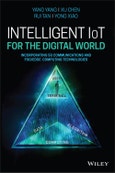DISCOVER HOW THE INTELLIGENT INTERNET OF THINGS WILL CHANGE THE INFORMATION AND COMMUNICATION TECHNOLOGY INDUSTRY IN THE NEXT DECADE
In the digital world, most data and Internet of Things (IoT) services need to be efficiently processed and executed by intelligent algorithms using local or regional computing resources, thus greatly saving and reducing communication bandwidth, end-to-end service delay, long-distance data transmissions, and potential privacy breaches. This book proposes a pyramid model, where data, computing and algorithm jointly constitute the triangular base to support a variety of user-centric intelligent IoT services at the spire by using different kinds of smart terminals or devices.
This book provides a state-of-the-art review of intelligent IoT technologies and applications, discusses the key challenges and opportunities facing the digital world, and answers the following five critical questions:- What is the most feasible network architecture to effectively provide sufficient resources anywhere anytime for intelligent IoT application scenarios?- How do we efficiently discover, allocate and manage computing, communication and caching resources in heterogeneous networks across multiple domains and operators?- How do we agilely achieve adaptive service orchestration and reliable service provisioning to meet dynamic user requirements in real time?- How do we effectively protect data privacy in IoT applications, where IoT devices and edge/fog computing nodes only have limited resources and capabilities?- How do we continuously guarantee and maintain the synchronization and reliability of wide-area IoT systems and applications?
Written for professionals working in 5G/IoT technology development, service management and big data analytics, this book offers an overview of intelligent IoT service architecture, key technologies, important applications and future technological trends.
Table of Contents
Preface ix
Acknowledgments xvii
Acronyms xix
1 IoT Technologies and Applications 1
1.1 Introduction 1
1.2 Traditional IoT Technologies 3
1.2.1 Traditional IoT System Architecture 3
1.2.2 IoT Connectivity Technologies and Protocols 7
1.3 Intelligent IoT Technologies 27
1.3.1 Data Collection Technologies 29
1.3.2 Computing Power Network 36
1.3.3 Intelligent Algorithms 39
1.4 Typical Applications 42
1.4.1 Environmental Monitoring 42
1.4.2 Public Safety Surveillance 42
1.4.3 Military Communication 44
1.4.4 Intelligent Manufacturing and Interactive Design 46
1.4.5 Autonomous Driving and Vehicular Networks 47
1.5 Requirements and Challenges for Intelligent IoT Services 48
1.5.1 A Generic and Flexible Multi-tier Intelligence IoT Architecture 48
1.5.2 Lightweight Data Privacy Management in IoT Networks 49
1.5.3 Cross-domain Resource Management for Intelligent IoT Services 50
1.5.4 Optimization of Service Function Placement, QoS, and Multi-operator Network Sharing for Intelligent IoT Services 50
1.5.5 Data Time stamping and Clock Synchronization Services for Wide-area IoT Systems 51
1.6 Conclusion 52
References 52
2 Computing and Service Architecture for Intelligent IoT 61
2.1 Introduction 61
2.2 Multi-tier Computing Networks and Service Architecture 62
2.2.1 Multi-tier Computing Network Architecture 63
2.2.2 Cost Aware Task Scheduling Framework 65
2.2.3 Fog as a Service Technology 69
2.3 Edge-enabled Intelligence for Industrial IoT 74
2.3.1 Introduction and Background 74
2.3.2 Boomerang Framework 79
2.3.3 Performance Evaluation 83
2.4 Fog-enabled Collaborative SLAM of Robot Swarm 85
2.4.1 Introduction and Background 85
2.4.2 A Fog-enabled Solution 87
2.5 Conclusion 93
References 94
3 Cross-Domain Resource Management Frameworks 97
3.1 Introduction 97
3.2 Joint Computation and Communication Resource Management for Delay-Sensitive Applications 99
3.2.1 2C Resource Management Framework 101
3.2.2 Distributed Resource Management Algorithm 104
3.2.3 Delay Reduction Performance 107
3.3 Joint Computing, Communication, and Caching Resource Management for Energy-efficient Applications 113
3.3.1 Fog-enabled 3C Resource Management Framework 116
3.3.2 Fog-enabled 3C Resource Management Algorithm 121
3.3.3 Energy Saving Performance 127
3.4 Case Study: Energy-efficient Resource Management in Tactile Internet 131
3.4.1 Fog-enabled Tactile Internet Architecture 133
3.4.2 Response Time and Power Efficiency Trade-off 135
3.4.3 Cooperative Fog Computing 137
3.4.4 Distributed Optimization for Cooperative Fog Computing 139
3.4.5 A City-wide Deployment of Fog Computing-supported Self-driving Bus System 140
3.5 Conclusion 144
References 145
4 Dynamic Service Provisioning Frameworks 149
4.1 Online Orchestration of Cross-edge Service Function Chaining 149
4.1.1 Introduction 149
4.1.2 Related Work 151
4.1.3 System Model for Cross-edge SFC Deployment 152
4.1.4 Online Optimization for Long-term Cost Minimization 157
4.1.5 Performance Analysis 162
4.1.6 Performance Evaluation 165
4.1.7 Future Directions 169
4.2 Dynamic Network Slicing for High-quality Services 170
4.2.1 Service and User Requirements 170
4.2.2 Related Work 173
4.2.3 System Model and Problem Formulation 174
4.2.4 Implementation and Numerical Results 176
4.3 Collaboration of Multiple Network Operators 180
4.3.1 Service and User Requirements 181
4.3.2 System Model and Problem Formulation 182
4.3.3 Performance Analysis 187
4.4 Conclusion 189
References 190
5 Lightweight Privacy-Preserving Learning Schemes 197
5.1 Introduction 197
5.2 System Model and Problem Formulation 199
5.3 Solutions and Results 200
5.3.1 A Lightweight Privacy-preserving Collaborative Learning Scheme 200
5.3.2 A Differentially Private Collaborative Learning Scheme 213
5.3.3 A Lightweight and Unobtrusive Data Obfuscation Scheme for Remote Inference 218
5.4 Conclusion 233
References 233
6 Clock Synchronization for Wide-area Applications 239
6.1 Introduction 239
6.2 System Model and Problem Formulation 240
6.2.1 Natural Timestamping for Wireless IoT Devices 240
6.2.2 Clock Synchronization forWearable IoT Devices 241
6.3 Natural Timestamps in Powerline Electromagnetic Radiation 243
6.3.1 Electrical Network Frequency Fluctuations and Powerline Electromagnetic Radiation 243
6.3.2 Electromagnetic Radiation-based Natural Timestamping 244
6.3.3 Implementation and Benchmark 251
6.3.4 Evaluation in Office and Residential Environments 254
6.3.5 Evaluation in a Factory Environment 259
6.3.6 Applications 261
6.4 Wearables Clock Synchronization Using Skin Electric Potentials 269
6.4.1 Motivation 269
6.4.2 Measurement Study 271
6.4.3 TouchSync System Design 276
6.4.4 TouchSync with Internal Periodic Signal 285
6.4.5 Implementation 288
6.4.6 Evaluation 290
6.5 Conclusion 297
References 297
7 Conclusion 301
Index 305








